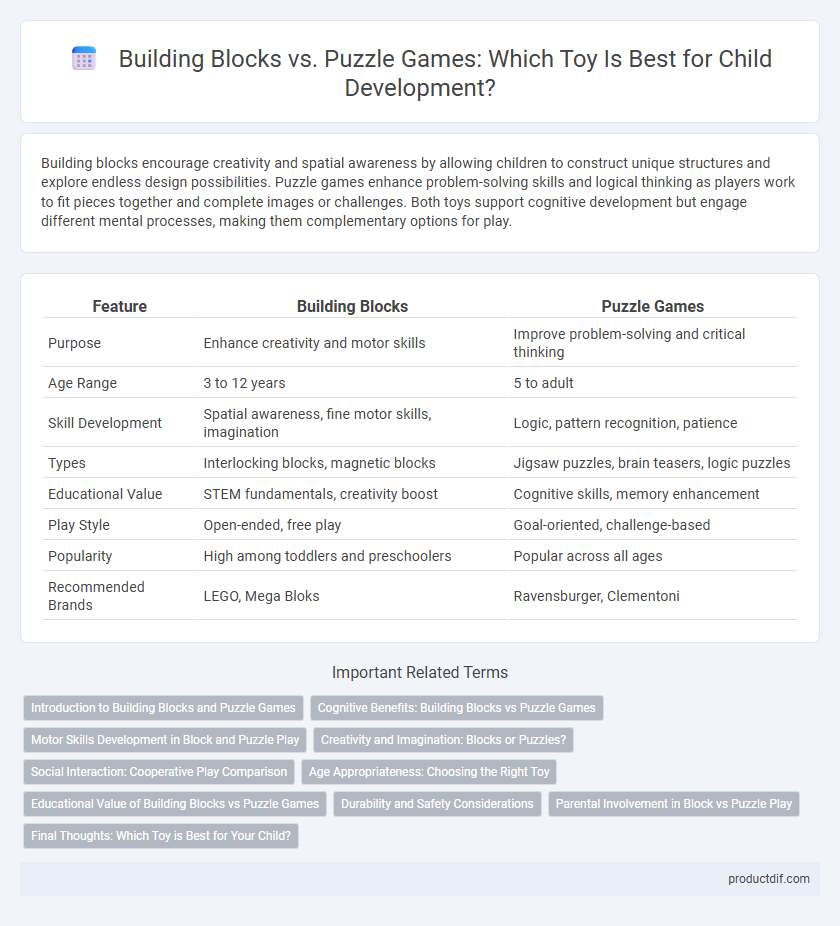Building blocks encourage creativity and spatial awareness by allowing children to construct unique structures and explore endless design possibilities. Puzzle games enhance problem-solving skills and logical thinking as players work to fit pieces together and complete images or challenges. Both toys support cognitive development but engage different mental processes, making them complementary options for play.
Table of Comparison
| Feature | Building Blocks | Puzzle Games |
|---|---|---|
| Purpose | Enhance creativity and motor skills | Improve problem-solving and critical thinking |
| Age Range | 3 to 12 years | 5 to adult |
| Skill Development | Spatial awareness, fine motor skills, imagination | Logic, pattern recognition, patience |
| Types | Interlocking blocks, magnetic blocks | Jigsaw puzzles, brain teasers, logic puzzles |
| Educational Value | STEM fundamentals, creativity boost | Cognitive skills, memory enhancement |
| Play Style | Open-ended, free play | Goal-oriented, challenge-based |
| Popularity | High among toddlers and preschoolers | Popular across all ages |
| Recommended Brands | LEGO, Mega Bloks | Ravensburger, Clementoni |
Introduction to Building Blocks and Puzzle Games
Building blocks offer hands-on learning experiences by promoting creativity, spatial awareness, and fine motor skills in children. Puzzle games enhance cognitive development through problem-solving, pattern recognition, and logical thinking challenges. Both toy categories support brain growth but engage different developmental areas, making them complementary activities for early childhood education.
Cognitive Benefits: Building Blocks vs Puzzle Games
Building blocks enhance spatial reasoning and fine motor skills by encouraging children to manipulate shapes and understand structural concepts. Puzzle games improve problem-solving abilities and memory through pattern recognition and logical thinking challenges. Both toys foster cognitive development but target different brain functions essential for early learning and creativity.
Motor Skills Development in Block and Puzzle Play
Building blocks enhance fine motor skills by encouraging precise hand and finger movements during stacking and assembling, which promotes hand-eye coordination and spatial awareness. Puzzle games develop problem-solving abilities and cognitive flexibility while also improving dexterity through piece manipulation and placement. Both activities engage different aspects of motor skills development, making them essential for comprehensive childhood growth.
Creativity and Imagination: Blocks or Puzzles?
Building blocks foster open-ended creativity by allowing children to construct unique structures and experiment with spatial concepts, enhancing imaginative play. Puzzle games, on the other hand, develop problem-solving skills through pattern recognition and logical thinking, offering structured yet stimulating challenges. Both toys support cognitive growth, but blocks provide a more expansive platform for creative expression and imaginative development.
Social Interaction: Cooperative Play Comparison
Building blocks foster social interaction through cooperative play by encouraging teamwork, communication, and shared creativity as children collaborate to construct structures. Puzzle games also promote social engagement but often emphasize problem-solving and individual strategy before group discussion. Both toys enhance social skills, yet building blocks more directly support dynamic, real-time cooperation and joint decision-making.
Age Appropriateness: Choosing the Right Toy
Building blocks are ideal for toddlers aged 1 to 3 years, promoting fine motor skills and spatial awareness through large, easy-to-handle pieces. Puzzle games cater to children aged 4 and above, enhancing problem-solving abilities and cognitive development with varied complexity levels and piece counts. Selecting toys based on age appropriateness ensures developmental benefits and maintains safety standards.
Educational Value of Building Blocks vs Puzzle Games
Building blocks enhance spatial reasoning, fine motor skills, and creativity by encouraging open-ended construction and problem-solving. Puzzle games improve cognitive functions such as memory, pattern recognition, and critical thinking through structured challenges and goal-oriented tasks. Both toys support educational development, but building blocks provide a more versatile learning experience by fostering imagination alongside logical skills.
Durability and Safety Considerations
Building blocks are designed with sturdy, non-toxic materials that withstand repeated use and enhance child safety, reducing choking hazards through larger, interlocking pieces. Puzzle games often involve smaller, intricate components that may pose a higher risk of breakage and ingestion, necessitating careful supervision and age-appropriate selections. Both toys require compliance with international safety standards such as ASTM F963 and EN71 to ensure durability and protect children during play.
Parental Involvement in Block vs Puzzle Play
Parental involvement in building blocks play often encourages creativity and spatial reasoning as parents guide construction and problem-solving processes. In puzzle games, parents typically focus on cognitive development and patience, helping children recognize shapes and patterns. Both playstyles benefit from active parental engagement, enhancing fine motor skills and critical thinking abilities.
Final Thoughts: Which Toy is Best for Your Child?
Building blocks enhance spatial reasoning, creativity, and fine motor skills by allowing children to construct and experiment with various structures. Puzzle games improve critical thinking, problem-solving abilities, and hand-eye coordination through engaging challenges and pattern recognition. Choosing the best toy depends on your child's developmental needs and interests, with building blocks fostering open-ended play and puzzles encouraging focused cognitive skills.
Building blocks vs puzzle games Infographic

 productdif.com
productdif.com